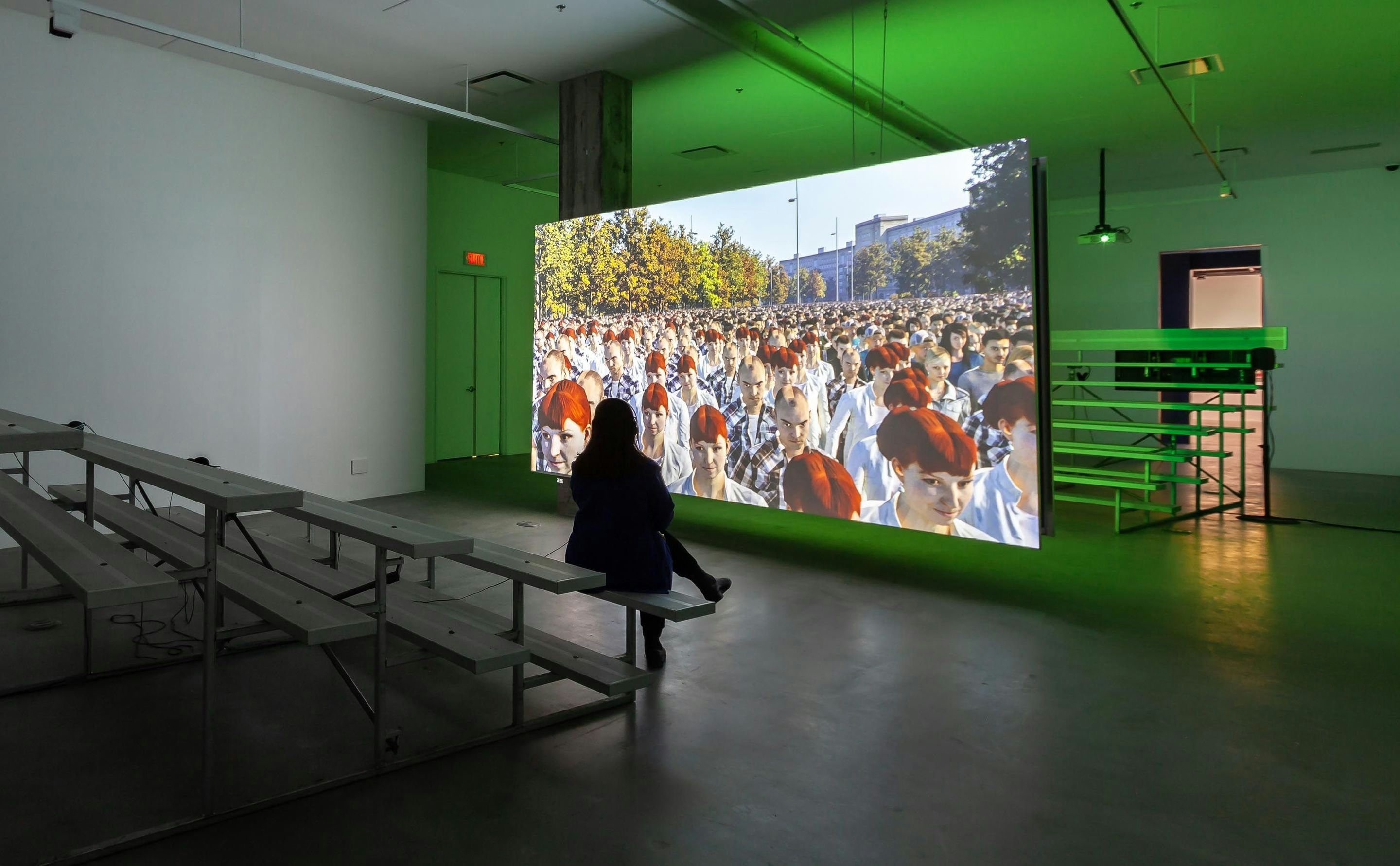
Clemens von Wedemeyer
The Illusion of a Crowd
2022.03.10 - 05.28
This first monographic exhibition in Canada devoted to German artist Clemens von Wedemeyer comprises a selection of video installations and a visual essay pertaining to the representation of crowds and the tensions between the individual and the masses.
To that end, the artist revisits the writings of Elias Canetti (1960) on the psychology of crowds. Whereas Canetti was addressing the rise of fascism in the first half of the 20th century, Wedemeyer transposes his ideas to the era of Big Data, artificial intelligence and the modelling of human behaviour in surveillance capitalism. With simulations of crowd dynamics, from those used by police forces and public authorities for disaster scenarios to digitally created crowd scenes in blockbuster films, a new visibility of social relations emerges. Wedemeyer employs varied formats—documentary, fiction, screen-captured video, computer-generated imagery and found footage—to show that, while the tools of technology used to exert control are constantly evolving, the quest for power in digital capitalism remains highly contested.
Dusk, Night is Falling. On Temporary Collectivity
LISA STUCKEY
“Power is indeed of the essence of all government, but violence is not. Violence is by nature instrumental; like all means, it always stands in need of guidance and justification through the end it pursues.” 1 —Hannah Arendt
Coup, insurrection, parade, protest, resistance, revolution, or rioting mob: terminologies like these require a careful contextual analysis within (counter-)hegemonic narratives. Clemens von Wedemeyer’s moving-image works and his artist’s publication The Illusion of a Crowd (2020) provide a comprehensive insight into how visual culture displays such forms of temporary collectivity.

In the film Emergency Drill Revisited (2020), documenting a rehearsal by the civil protection unit of Leipzig, he investigates a scenario that serves to re-establish the status quo after a situation of distress. Dedicated to a future state of affairs, his found-footage montage Transformation Scenario (2018) is based on the premise of exchanging one’s physicality for a virtual alter ego. In Crowd Control (2018) he addresses logistics: based on a police simulation program to prepare officers for encounters with crowds, the artist’s interest concerns the control of people flows such as the organization of complex operations through the perspective of executive force.
When, however, does a protest become an intervention of the masses into historiography? Wedemeyer’s work 70.001 (2019) takes into consideration the intentions of the Monday demonstrations that occurred in the city of Leipzig in the former German Democratic Republic in 1989. He therein tests how a shared political memory can be kept alive through transfers of historical accounts and recordings to different media milieus. Montage and editing, hitherto central to Wedemeyer’s storytelling, become secondary modalities. Simulation allows a virtual camera to navigate the urban set without cuts, to tell several episodes through daylight and “dusk, night is falling”2 in a time warp, and to fluidly switch from a bird’s-eye perspective to close-ups. A zoom into the demonstrating crowd, whose march comes to a still at Roßplatz, reveals the technicality of the depiction: apathetic faces of so-called “digital agents” stare past the camera. Glitches run through their animated bodies, which appear without anima. In this illustration of a crowd of proxies or dummies, one could see a warning against homogenization encountered in an existentialist view of praxis: “In [Jean-Paul] Sartre’s radically conflictual [. . .] model of human history, praxis can be realized only by alienating oneself.”3 In 70.001, voices originating from audio footage of the Monday demonstrations become the anima of the digital teenagers, who resemble one another and have agency only as a crowd. In addition, commemoration of the events is staged in separate interviews with contemporary witnesses, whose talking heads testify to a by-now common notion of a nation’s historical psyche.
In Juliane Rebentisch’s philosophical analysis of the art of freedom, one reads that unlike Plato, Jean-Jacques Rousseau did not think of democracy in terms of theatre, but positively in terms of assembly, and therefore defended democracy from its theatricalization; in contrast to the common assumption that in theatre an actor is not identical with his role, Rousseau feared the congruence between role and identity.4 Do today’s simulated figures still face the danger of confounding role and identity? Modern connotations of the mass were twofold: with the rise of the bourgeoisie (between people and nobility) the mass, “characterized not only by its lack of education and its potential violence but also by its association with labor,” was narrowed down due to the wish to distinguish oneself from it, while at the same time those characteristics were “lauded and even glorified in revolutionary literature.”5 Keeping in mind the high number of extras that would have been needed for a physical (filmic or theatrical) re-enactment, Wedemeyer’s work addresses less the concept of the proletariat than transformations of labour within post-cinematic dispositives: usually silent extras are now released or deprived of their service as background actors—at least when understood as a “Schauspieler [. . .] who [. . .] shows a play, a theatrical illusion,” making room for the “Akteur [. . .] [, which] designates the person who is at the head of a political action”6 or even for a leaderless agency. How can Wedemeyer’s visual translations of the research of Elias Canetti on Masse und Macht (1960) contribute to an understanding of present democratic movements such as the 2019–21 Hong Kong protests that make discernible how the conditions of decentral organization (along with their motto “be water”) through mass technology have changed?
The events of the date referenced in 70.001, October 9, 1989, could only happen due to a vertical corporation and partial insubordination of security personnel. Once the force of the police’s presence faded into the background, the chorus (stemming from the ancient Greek tragedy, comedy and satyr play) of the demos promised to become a revolutionary power. Oscillating between approval for the protesters’ peaceful action and a distant reflection of mass and power, 70.001 remains within these radical ambiguities.
Clemens von Wedemeyer’s investigations into the visual-political representations of crowds such as the technical and socio-political programmability of behaviour7 appear to partly sympathize with behaviourism’s critique on the “myth of interiority,”8 forming a negative foil not only to the philosophy of mind, but also to depth psychology evolving around 1900. With the then parallel development of cinema and psychoanalysis, a thinking about Wedemeyer’s work suggests both a contemplation of media-theoretical genealogies and a mapping of a diversified history of ideas of concepts such as actor, agency, behaviour, mass, power, praxis, and historicity. In today’s future industries information management plays an increased role. By inserting “1” into the established number of 70,000 demonstrators on the mentioned day, the artist shows that such counts are in fact recounts—thereby opening narrative structures for speculative actualizations.
This exhibition is made possible through the financial support of IFA (Institut für Auslandsbeziehungen). It is part of VOX’s new research axis devoted to investigatory images.
